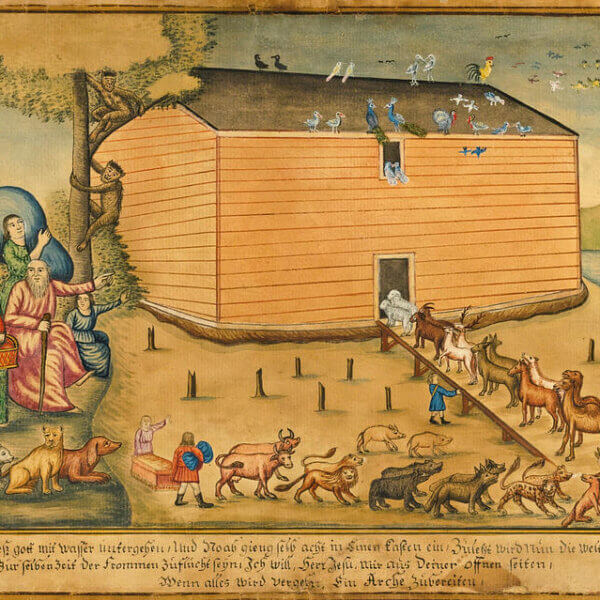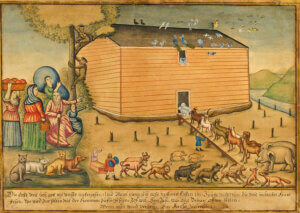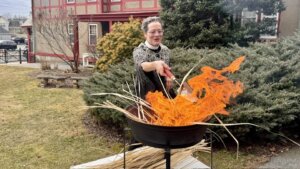
What Is Your Wilderness?
 My younger classmates in divinity school used to talk about the Choose Your Own Adventure stories, a series of youth stories that they grew up with where each story is written from a second-person point of view, making the reader the main character in the story, and allowing the reader to make choices that determine the main character’s actions and the plot’s outcome. The stories are formatted so that after a few pages of reading, the protagonist faces two or three options, each of which leads to further pages and further options, until they arrive at one of the many different story endings. The number of endings varies from as many as 44 to as few as 7, with no clear pattern regarding the ratio of good to bad endings, or the reader’s progression backwards and forwards through the pages of the book. These choices give the stories a realistic sense of unpredictability, and allows readers to have a new experience each time they read the story. As I’ve been preparing for our journey together through Lent, I find myself returning to the Choose Your Own Adventure theme.
My younger classmates in divinity school used to talk about the Choose Your Own Adventure stories, a series of youth stories that they grew up with where each story is written from a second-person point of view, making the reader the main character in the story, and allowing the reader to make choices that determine the main character’s actions and the plot’s outcome. The stories are formatted so that after a few pages of reading, the protagonist faces two or three options, each of which leads to further pages and further options, until they arrive at one of the many different story endings. The number of endings varies from as many as 44 to as few as 7, with no clear pattern regarding the ratio of good to bad endings, or the reader’s progression backwards and forwards through the pages of the book. These choices give the stories a realistic sense of unpredictability, and allows readers to have a new experience each time they read the story. As I’ve been preparing for our journey together through Lent, I find myself returning to the Choose Your Own Adventure theme.
We don’t exactly get to choose our own Lenten wilderness, but we do encounter God when we choose our own adventure in the wilderness that we’re given. What is your wilderness? Wilderness can take on different shapes and characteristics. And being in the wilderness, whether intentionally during the 40 days and nights of Lent, or unexpectedly over undefined periods of illness, grief, care for a loved one, or even intense training or preparation for a task, is not necessarily bad. But we have the opportunity to learn important things in the wilderness, and we do have real choices in how we respond.
Noah’s Wilderness
 What is your wilderness? Noah’s wilderness was confined and highly populated. When Noah’s 40 days and nights in his wilderness began, he loaded up the ark with 8 humans — his wife, their sons, and their sons’ wives — and two of every other living thing, male and female:
What is your wilderness? Noah’s wilderness was confined and highly populated. When Noah’s 40 days and nights in his wilderness began, he loaded up the ark with 8 humans — his wife, their sons, and their sons’ wives — and two of every other living thing, male and female:
Of the birds according to their kinds, and of the animals according to their kinds, and of every creeping thing of the ground according to its kind, two of every kind shall come in to you, to keep them alive. Also take with you every kind of food that is eaten, and store it up; and it shall serve as food for you and for them.
Jesus’ wilderness adventure in Mark’s gospel is the most spare account we have among the different gospels’ versions of the temptation story. There are no detailed descriptions of fasting, or particular temptations over ego, earthly power, or control over his future. Instead, we see only Jesus, Satan, the wild beasts, and the angels who waited on Jesus, as Mark’s gospel tells us. (Jesus has that wild beast part in common with Noah.) And we’re there with Jesus too — all of us reading the story now. The reader is present in Jesus’ temptation in the wilderness just as we are crowded onto the ark with Noah, his family, and representatives of all the living creatures of the earth — along with all of their food supplies. That’s how we get to know the story, to understand how Jesus and Noah responded to their wilderness experiences, so we can choose how to respond to the wilderness we’re given. Noah didn’t have a way out of his crowded wilderness until the floods abated.
No Way But Through
 And when we find ourselves in an unintended wilderness of illness, loss, care for a loved one, or other hardship, there’s really no way out but through. But when we can choose our own adventure, as we are doing together in community at Emmanuel this Lent, our wilderness is more accessible — a place any of us can go any time to think, pray, and figure out what’s really important in our lives of faith, and what really matters in our lives in community with God. This last week, after we had celebrated Fat Wednesday with pancakes and King Cake in the Library, I mixed the ashes from last year’s palms with holy nard from Jerusalem. Nard is the same precious oil that the woman with the alabaster jar used to anoint Jesus’ still-living feet.
And when we find ourselves in an unintended wilderness of illness, loss, care for a loved one, or other hardship, there’s really no way out but through. But when we can choose our own adventure, as we are doing together in community at Emmanuel this Lent, our wilderness is more accessible — a place any of us can go any time to think, pray, and figure out what’s really important in our lives of faith, and what really matters in our lives in community with God. This last week, after we had celebrated Fat Wednesday with pancakes and King Cake in the Library, I mixed the ashes from last year’s palms with holy nard from Jerusalem. Nard is the same precious oil that the woman with the alabaster jar used to anoint Jesus’ still-living feet.
I’ve always liked to use nard with the ashes, both for its beautiful fragrance and for the reminder that it’s holy to notice, and to bless, what is living during Lent, and to be very concerned about our lives in community. We were fragrant worshipers when we came together to exchange the Peace Wednesday night, with the holy nard scenting the ash crosses on our foreheads. Civilizations have used ashes as fertilizer throughout human history, and I hope that our holy ashes nourish us as we prepare to respond to God in our community this Lent. Over the next six Wednesdays, we’ll explore our responses to the opportunity of wilderness in a series of simple suppers of hearty soup and homemade bread. Jere will serve as facilitator in these six conversations, beginning with an overview of the ways Lent has been adapted by local custom and theological differences, walking our modern culture’s line between the festive spirit of Mardi Gras and the self-improvement spirit of New Year’s resolutions.
Another Wednesday, we’ll read poetry that finds a voice for the internal, subjective nature of spiritual life that is difficult to articulate. In another conversation, we’ll explore why we are drawn to music for inspiration in our Lenten devotion. We’ll talk about the psychology of temptation itself, and how developments in therapy can help us understand its nature, and on another Wednesday, how the visual arts can deepen our understanding of Lent. And we’ll put all these conversations in perspective with our conversation the Wednesday before Holy Week, when we’ll wonder with Maggi Dawn how our individual spiritual exploration and growth through Lent is joined with that of others to strengthen our Christian community. We can’t always choose our own wilderness, but we can choose how we respond to that wilderness’s opportunity for growth and change. Join us. The only price of admission is a can of soup for the MLK Food Pantry. Amen
